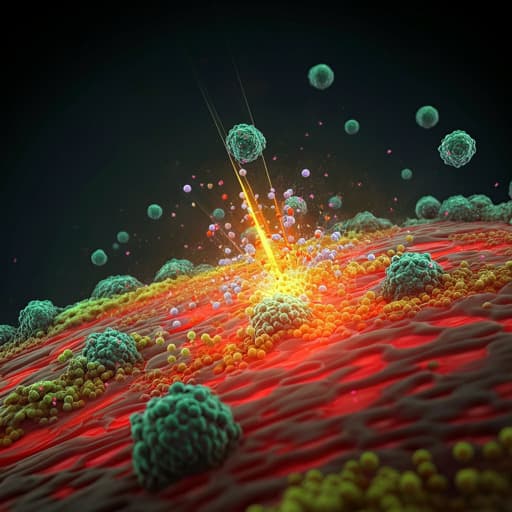
Biology
Nanotechnology as a Promising Approach to Combat Multidrug Resistant Bacteria: A Comprehensive Review and Future Perspectives
H. F. Hetta, Y. N. Ramadan, et al.
Explore the innovative use of nanotechnology in combating multidrug-resistant bacteria and biofilms, a significant global health threat. This research, conducted by H F Hetta, Y N Ramadan, A I Al-Harbi, E A Ahmed, Basem Battah, and Noura H Abd Ellah, reveals mechanisms of antibiotic resistance and presents nanoscale strategies to enhance antibacterial efficacy.
~3 min • Beginner • English
Introduction
Antimicrobial resistance (AMR) has become a critical global health challenge, with at least 1.27 million deaths directly attributable to bacterial AMR and about 5 million associated deaths in 2019. The rapid spread of resistance, gene sharing among bacteria, and biofilm formation have accelerated the emergence of multidrug-resistant (MDR) and extensively drug-resistant (XDR) pathogens, particularly within the ESKAPE group. Conventional antibiotics face declining efficacy, and biofilm-associated infections exhibit antibiotic susceptibilities 100–1000 times lower than planktonic cells. In response, nanotechnology-based approaches are being explored to improve antimicrobial delivery, target specificity, and efficacy, and to introduce novel bactericidal mechanisms capable of overcoming established resistance pathways. This review outlines resistance mechanisms, the epidemiology and burden of MDR/XDR bacteria, and the current advances in nanoparticle (NP) design, mechanisms of action, and therapeutic applications, including synergistic nanoantibiotic strategies.
Literature Review
The review synthesizes current knowledge across several thematic areas: (1) Mechanisms of antibiotic resistance: enzymatic drug inactivation (e.g., β-lactamases/ESBLs), target modification (e.g., methylation of 23S rRNA, altered PBPs in MRSA), decreased uptake (porin changes), efflux pump upregulation, activation of alternative metabolic pathways, horizontal gene transfer, persister cell formation, and biofilm-mediated protection. (2) Spread and burden of MDR/XDR bacteria: MDR organisms, especially ESKAPE pathogens, are linked to high morbidity, mortality, and costs; biofilms contribute to 65–80% of human infections and drastically reduce antibiotic susceptibility. Global misuse and overuse of antibiotics drive approximately 80% of MDR/XDR cases, with projections of 10 million annual deaths by 2050 without intervention. (3) Types and formulations of nanoparticles: Organic NPs (liposomes, polymeric NPs such as PLGA, dendrimers, micelles) improve drug loading, stability, and delivery; inorganic NPs (metals and metal oxides like Ag, Au, CuO, ZnO, TiO2, MgO, SiO2) possess intrinsic antibacterial activity; hybrids (e.g., lipid–polymer systems, polymer–gold, magnetic polymer matrices anchoring Ag NPs) combine advantages to enhance targeting, sustained release, and efficacy. (4) Mechanisms of NP antibacterial action: disruption of cell wall/membrane, ROS generation and oxidative stress, interference with intracellular targets (DNA, proteins, enzymes, ribosomes), efflux pump damage, electron transport chain inhibition, and biofilm penetration/disruption. (5) Free antibiotics vs nanoantibiotics: Nanoscale carriers enable targeted, controlled release, reduced dosing frequency and amounts, protection from degradation, and dual modes of action (antibiotic plus NP effects). (6) Synergistic nanoantibiotics: Multiple examples demonstrate enhanced activity of antibiotic–NP combinations against MDR strains and biofilms (e.g., amoxicillin or ampicillin with AgNPs or AuNPs; gentamicin-loaded PLGA NPs; alginate NP–colistin combinations; bimetallic core–shell nanoarchitectures with linezolid). (7) Activity against different bacterial states: Evidence of efficacy against planktonic ESKAPE pathogens, intracellular bacteria (e.g., Salmonella spp., Mycobacterium tuberculosis, M. avium), and biofilms (optimized NP size/charge for EPS penetration; polymeric carriers for high local concentration and controlled release). (8) Strengths and challenges: NPs offer targeted, sustained delivery and multi-mechanistic action but face challenges including optimal dosing, delivery routes, interactions with biological systems, short- and long-term toxicity, biodistribution/accumulation, occupational and environmental exposure, and financial considerations for clinical translation.
Methodology
This is a narrative, comprehensive review article synthesizing published literature on antibiotic resistance, MDR/XDR epidemiology, nanoparticle types and formulations, mechanisms of antibacterial action, and synergistic nanoantibiotic strategies. No primary experimental methodology, systematic search strategy, or meta-analysis procedures are described.
Key Findings
- AMR burden: At least 1.27 million deaths directly attributable to bacterial AMR and ~5 million associated deaths in 2019; MDR bacteria responsible for at least 700,000 deaths annually worldwide (including 23,000 in the US and 25,000 in the EU). Without action, up to 10 million deaths annually by 2050 are projected. Approximately 80% of MDR/XDR cases are linked to misuse/overuse of antibiotics.
- Biofilms: Implicated in 65–80% of human infections; biofilm cells exhibit antibiotic susceptibilities typically 100–1000 times lower than planktonic cells due to EPS barriers, reduced drug penetration and uptake, altered metabolism, and resistance gene transfer.
- Nanoparticle modalities: Organic (liposomes, PLGA, dendrimers, micelles), inorganic (Ag, Au, CuO, ZnO, TiO2, MgO, SiO2), and hybrid (lipid–polymer, polymer–Au, magnetic polymer–Ag) systems enable improved delivery, stability, targeting, and/or intrinsic antibacterial mechanisms.
- Mechanisms of action: NPs disrupt bacterial cell walls/membranes, produce ROS leading to oxidative damage of lipids, proteins, enzymes, and nucleic acids, damage efflux pumps, inhibit the electron transport chain, and penetrate/disrupt biofilms; positively charged NPs show strong interactions with negatively charged bacterial surfaces and biofilm matrices.
- Synergy with antibiotics: Numerous combinations show enhanced efficacy against MDR pathogens and biofilms, e.g., amoxicillin+AgNPs; AgNP–ampicillin complexes (greater activity vs S. aureus, E. coli, K. mobilis); ampicillin on AuNP/AgNP interfaces (bypass MDR mechanisms in P. aeruginosa, Enterobacter aerogenes, MRSA); gentamicin-loaded PLGA NPs (improved in vitro/in vivo activity vs P. aeruginosa); alginate NP–colistin combinations (restore activity vs colistin-resistant E. coli); bimetallic Au/Ag core–shell with linezolid (broad bactericidal action including MRSA).
- Intracellular infections: NPs facilitate delivery into eukaryotic cells to target intracellular bacteria. Examples include multimetallic microparticles containing Ag/ZnO for MTb-infected macrophages; ZnO and MgO–ZnO NPs with activity against MDR-MTb; inhalable ATRA-loaded PLGA NPs as host-directed TB therapy; PLGA NPs delivering anti-TB drugs to enhance efficacy and macrophage bactericidal responses; liposomal colistin to promote cellular internalization; gentamicin-loaded AuNPs eliminating intracellular L. monocytogenes and P. aeruginosa.
- Biofilm control: Optimizing NP size and charge enhances EPS penetration (cationic and ≤350 nm particles show better mobility). Polymeric carriers provide high local concentrations and controlled release; ZnO NPs with pancreatin show anti-MRSA antibiofilm activity; PLGA micro/nanoparticles with ciprofloxacin effective against S. aureus and P. aeruginosa biofilms.
- Safety/translation: Despite promise, no FDA-approved systemic nanoantibiotics for human use exist to date due to unresolved issues in toxicity, biodistribution, PK/PD, long-term safety, and cost-effectiveness.
Discussion
The review addresses the urgent need for new strategies against MDR/XDR pathogens by detailing how nanotechnology can overcome limitations of conventional antibiotics. Nanoparticles provide multi-targeted antibacterial mechanisms (membrane disruption, ROS generation, intracellular interference) that can bypass or reduce the impact of established resistance pathways. As carriers, NPs improve drug stability, bioavailability, targeted delivery, and controlled release, thereby enhancing therapeutic efficacy while potentially lowering required doses and reducing host toxicity. Synergistic combinations of antibiotics with NPs demonstrate substantial improvements against planktonic, intracellular, and biofilm-associated infections, including ESKAPE pathogens and MDR Mycobacterium. These findings underscore nanotechnology’s potential to restore antibiotic effectiveness and mitigate resistance selection by avoiding sub-MIC exposure and engaging multiple bactericidal modes of action. However, the translation of these advances requires addressing safety, biodistribution, long-term exposure, and regulatory/financial barriers to realize clinical impact.
Conclusion
Nanomaterials offer an innovative, promising approach to treat persistent MDR planktonic and biofilm infections. Optimizing physicochemical properties (size, surface charge) is key to maximizing therapeutic efficacy and minimizing host risk. Current clinical use is limited by uncertainties regarding long-term systemic safety, metabolic and stability issues, detailed gene-level mechanisms, and interactions with biological systems. Future work should elucidate NP–biological interactions and gene expression effects, refine PK/PD and safety profiles, and design nanomaterials responsive to varied biological environments. With further development and validation, nanoantibiotics are poised to serve as next-generation therapeutics against MDR bacteria.
Limitations
- Review nature: No primary experimental methods or systematic review protocol reported.
- Safety and toxicity: Unresolved short- and long-term toxicity, including potential oxidative stress–mediated organ toxicities (hepatotoxicity, lung toxicity), metabolic alterations, and nanotoxicity upon therapeutic use.
- Biodistribution/accumulation: Systemic administration may lead to accumulation in spleen, lungs, bone marrow; inhaled NPs can distribute to lung, heart, liver, spleen, brain.
- Exposure risks: Occupational and environmental exposures (e.g., inhalation of airborne NPs) may present unanticipated health risks.
- Clinical translation: Lack of FDA-approved systemic nanoantibiotics; need for robust PK/PD, safety, and efficacy evaluations and consideration of cost-effectiveness.
- Delivery challenges: Optimal dosing, administration routes, cellular uptake mechanisms, and interactions with cells, tissues, and organs require further study.
Related Publications
Explore these studies to deepen your understanding of the subject.







